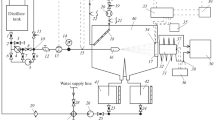Abstract
The cooling effect of liquid droplets introduced into a hot gas stream flowing in an adiabatic duct is analysed. The coupled interaction between the changes in the droplets and in the surrounding gas conditions is examined as a result of droplets vaporization. It was found that the use of liquid sprays as a rapid cooling process for a hot gas discharge is quite effective.
Similar content being viewed by others
Abbreviations
- A :
-
area
- A d :
-
droplet surface area
- C d :
-
drag coefficient
- c p :
-
specific heat at const. Pressure
- D :
-
mass diffusivity
- F :
-
drag force on a droplet
- Σ F :
-
summation of drag forces over the number of the droplets
- h :
-
heat transfer coefficient
- h g :
-
enthalpy of gas
- h d :
-
enthalpy of droplet
- k :
-
thermal conductivity
- k m :
-
mass transfer coefficient
- M :
-
mass of droplet
- mg :
-
mass flow rate of gas
- m d :
-
mass flow rate of droplets of one size
- Σ m d :
-
total mass flow rates of droplets summed over all sizes
- ℳ:
-
molecular weight
- N :
-
percent of drops having radii smaller than r
- N u :
-
Nusselt number
- P :
-
pressure
- P s :
-
static pressure
- P r :
-
Prandtl number
- R :
-
universal gas constant
- r m :
-
mass median drop radius
- r :
-
radial distance from center of droplet
- r d :
-
drop radius
- r n :
-
defined in (2)
- ℛ:
-
percent of mass in droplets smaller than r
- Re :
-
Reynolds number
- Sc :
-
Schmidt number
- Sh :
-
Sherwood number
- T :
-
temperature
- t :
-
time
- T G :
-
gas temperature
- U :
-
velocity difference between gas and the droplet
- V g :
-
gas velocity
- V d :
-
droplet velocity
- w :
-
vaporization rate
- α :
-
defined in (7)
- λ :
-
latent heat of vaporization
- μ :
-
viscosity; droplet size in micron
- ρ :
-
density
- δ :
-
vapor film thickness
- σ G :
-
geometric standard deviation
- d, D :
-
pertaining to droplet; droplet surface
- f:
-
vaporizing liquid vapor
- f, 0:
-
pertaining to the gas and the liquid vapor mixture
- f, d:
-
liquid at the surface of the droplet
- l:
-
liquid
- s:
-
gas static condition
- σ :
-
pertaining to the mass of droplets within the control volume
- g, G:
-
pertaining to the gas
References
Habib, I. S., Int. J. Heat Mass Transfer 13 (1970) 1378.
Priem, R. J. and M. F. Heidmann, “Propellant Vaporization as a Design Criterion for Rocket-Engine Combustion Chambers”, NASA TR R-67, (1960).
Ingebo, R. D., “Vaporization Rates and Drag Coefficients for Isooctane Sprays in Turbulent Air Streams”, NASA TN 3265, (1954).
Hougen, O. A. and K. M. Watson, Chemical Process Principles, John Wiley and Sons, Inc., (1943).
Author information
Authors and Affiliations
Rights and permissions
About this article
Cite this article
Habib, I.S. The rapid cooling of a hot gas discharge by liquid sprays. Appl. Sci. Res. 28, 62–72 (1973). https://doi.org/10.1007/BF00413057
Received:
Revised:
Issue Date:
DOI: https://doi.org/10.1007/BF00413057



